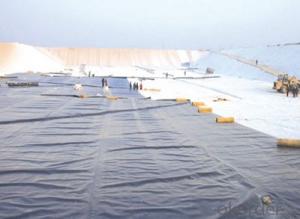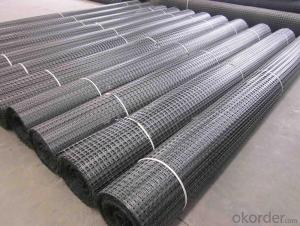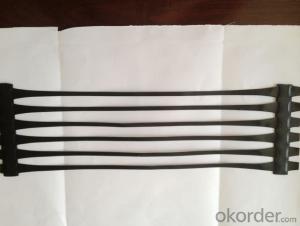Biaxial Geogrids HDPE Point Textured Geomembrane for River Bank Tunnel Canal Projects
- Loading Port:
- Tianjin
- Payment Terms:
- TT OR LC
- Min Order Qty:
- 88 m²
- Supply Capability:
- 1800000 m²/month
OKorder Service Pledge
OKorder Financial Service
You Might Also Like
Introduction of CNBM
China National Building Materials (Group) Corporation (CNBM) is a state-owned enterprise in charge of administrative affairs in China building materials industry. Established in 1984, CNBM is a large group corporation of building materials with total assets of RMB 25 billion and a total staff of 30,000. Now CNBM owns more than 200 subsidiaries in and abroad the country, including wholly-owned corporations and joint ventures.
FAQ of geosynthetics :
What is geosynthetics ?
Geosynthetics form a perfect erosion control fabric used extremely widely in civil engineering to stabilize and reinforce slopes and soil under or next to roads, railways, dams, water reservoirs etc.. They can be easily applied which minimizes the time of construction, as well as they limit the resources and materials necessary.
What kinds of geosynthetics we have ?
Non-woven geotextile, geogrids, geocells, GCL, Geomembranes, Geonets, Geocomposites etc .
What is the geosynthetics used for ?
Hydraulic
Lagooning and Water Treatment, Ornamental Ponds, Golf Courses
Aquaculture and Desalination,Water Lagoons,Tanks, Reservoirs, Liquid Waste,Floating Cover Solutions, Drainage and Filtration
Environment
Tailing ponds, Leach mining,Landfills,Landfill Capping,Protection against corrosion,Vertical Barriers
Civil Works
Erosion Control,Secondary Containment,Tunnels,Linear and Surface Works,Consolidation of Margins,Soil Reinforcement,Soil Separation.
Building - Parkings,Roofing,Soundproofing
The description of HDPE Geomembrane for Environmental Projects water conservancy projects landfill mining canal
Geomembranes are impermeable geosynthetics that, until recently, were mainly used as canal and pond liners. However, modern technology has broadened liner applications to include landfills, wastewater treatment lagoons, oil and gas exploration (including hydraulic fracturing or "fracking"), aquaculture, irrigation ponds and remediation. In many of these applications, a nonwoven geotextile is used as a cushion to protect the geomembrane. In general, geomembrane liners offer excellent puncture resistance and can withstand a wide range of chemicals and temperatures. They are also highly flexible and conform well to the subgrade.

The structure of HDPE Point Textured Geomembrane For river bank tunnel canel projects description:
One side or two sides uniformly point textured surface by special blow technology
Specification of HDPE Point Textured Geomembrane For river bank tunnel canel projects:
I. Thickness: L. Omm-3. Omm
2.4m-9m in width, roll length according to design or client ' s request
Features or Property of HDPE Point Textured Geomembrane For river bank tunnel canel projects:
Anti-crack, dimensional stability, anti-aging, smooth appearance, high friction coefficient.
Application of HDPE Point Textured Geomembrane For river bank tunnel canel projects:
I. Municipal projects
2. Landfill treatment projects
3. Waste water treatment
4. Mineral waterproofing
Production standard of HDPE Point Textured Geomembrane For river bank tunnel canel projects:
I. G B/T17643-2011 ( GH-2TI and GH-2T2 )
2. CJ/T234-2006
Area | Application of Geosynthetics |
Hydraulic | Lagooning and Water Treatment, Ornamental Ponds, Golf Courses Aquaculture and Desalination Water LagoonsTanks, Reservoirs, Liquid WasteFloating Cover SolutionsDrainage and FiltrationShading Cover Solutions |
Environment | Tailing ponds, Leach mining,Landfills,Landfill Capping,Protection against corrosion,Vertical Barriers |
Civil Works | Erosion Control, Secondary Containment, Tunnels,Linear and Surface Works,Consolidation of Margins,Soil Reinforcement,Soil Separation. |
Building | Parkings,Roofing,Soundproofing building |
- Q: Is there a geogrid in the transition section of Railway
- The railway section is to be used in the geogrid
- Q: Can geogrids be used in reinforcement of soft ground?
- Yes, geogrids can be used in the reinforcement of soft ground. Geogrids are commonly used in civil engineering projects to improve the stability and strength of weak or soft soils. They are designed to distribute loads and prevent soil movement, making them an effective solution for reinforcing soft ground and preventing settlement or failure.
- Q: What is the width of glass fiber grating 100cm
- Width 100cm refers to the width of 1.0m wide, the length can be customized according to the actual situation, such as 2m, 3M, etc..
- Q: Are geogrids resistant to freeze-thaw cycles?
- Yes, geogrids are generally resistant to freeze-thaw cycles. Their material composition and design allow them to withstand the expansion and contraction caused by freezing and thawing temperatures without significant damage. This resistance makes geogrids suitable for various applications in cold climates where freeze-thaw cycles are common.
- Q: Are geogrids resistant to aging?
- Yes, geogrids are generally resistant to aging. They are designed to withstand long-term exposure to environmental factors such as UV radiation, temperature fluctuations, and chemical exposure, which helps to maintain their strength and durability over time.
- Q: What are the design considerations for geogrid-reinforced embankments?
- Some key design considerations for geogrid-reinforced embankments include the selection of appropriate geogrid material, determining the required strength and stiffness of the geogrid, considering the effects of construction and installation techniques on the performance of the reinforcement, assessing the soil properties and slope stability of the embankment, and ensuring proper connection and interaction between the geogrid and the embankment materials. Additionally, factors such as long-term durability, potential for differential settlement, and environmental considerations should also be taken into account during the design process.
- Q: What is the geogrid GSJ80/HP
- The geogrid is divided into four categories: fiberglass geogrid, steel plastic geogrid, polyester geogrid and plastic geogrid.Characteristics of glass fiber geogrid:1, high tensile strength, low elongation - fiberglass geogrid with glass fiber as raw material, has a high resistance to deformation, fracture elongation rate of less than 3%.
- Q: Can geogrids be used in retaining walls for residential applications?
- Yes, geogrids can be used in retaining walls for residential applications. Geogrids are commonly used in retaining walls to enhance stability and improve the overall performance of the structure. They provide reinforcement and prevent soil erosion, which is crucial for the durability and longevity of residential retaining walls.
- Q: GDZ150 type one-way steel plastic welding geogrid D in the construction of the roadbed is horizontal paving also vertical spread?
- Because the direction of the force is mainly perpendicular to the direction of the line, your product is a one-way force of the product; if two-way products do not exist this problem.
- Q: How do geogrids enhance the performance of flexible retaining structures?
- Geogrids enhance the performance of flexible retaining structures by providing reinforcement and stability to the soil. They distribute the loads more evenly, reducing the stress on the structure and increasing its overall strength. Geogrids also prevent soil erosion and improve drainage, ensuring the long-term integrity and durability of the retaining structure.
Send your message to us
Biaxial Geogrids HDPE Point Textured Geomembrane for River Bank Tunnel Canal Projects
- Loading Port:
- Tianjin
- Payment Terms:
- TT OR LC
- Min Order Qty:
- 88 m²
- Supply Capability:
- 1800000 m²/month
OKorder Service Pledge
OKorder Financial Service
Similar products
Hot products
Hot Searches
Related keywords



























